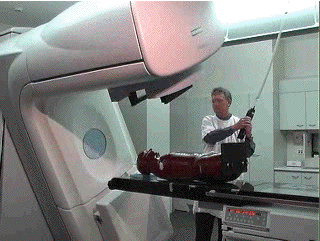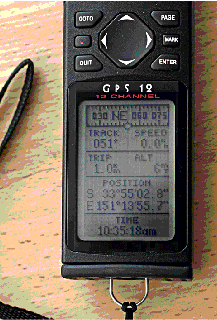|
|
|
| Relativity
in brief... or in detail.. |
Practial devices using relativityWhen ever one deals with particles with large energies, relativity becomes important. This is especially important for electrons because, with their low mass, they can be more easily accelerated than can protons and ions. Even the speed of satellites is high enough to require relativistic calculations if one needs high precision. Finally, we saw previously that even magnetism — which we use every time we use an electric motor — is, in a way, a relativistic effect. (See The electric and magnetic forces between moving charges.) Here are just a couple of examples in which relativity is used routinely, rather than as an exotic correction.
Medical accelerators and other high energy devices A 22 MeV electron accelerator. Courtesy Nigel Freeman (pictured), Radiation Oncology Medical Physics, St Vincent's Hospital, Sydney. It produces electron beams in which the electrons have energies up to 22 MeV. This gives them a relativistic factor g of 43, and a speed of 0.9997*c. Their momentum is 43 times greater than what Newtonian physics would predict for an electron travelling at that speed. So the magnetic fields used to control the beam must supply larger forces. The scientists and engineers who build such devices don't ask themselves whether relativity is true — they just use it. If you don't use relativity, you simply get the wrong answer, and a factor of 43 is very wrong. (Electron beams do not penetrate far, and so are mainly used to treat cancers close to the surface. For deeper tumours, X-rays from the same device are used. To produce such a beam, the electrons are collided with a copper block and much of their kinetic energy is converted into X-ray photons.) GPS and other precise measurementsThis commercial Global Positioning System (GPS) receiver is showing the latitude, longitude and altitude of a position on the University of New South Wales campus, in Eastern Sydney. Notice that it gives the position to tenths of a second of arc. A minute of arc in latitude is one nautical mile, or 1800 metres. So a second is 30 metres and so the last digit on the display, if accurate, would represent position with a precision of 3 metres - not just which building, but which room. In fact, even a cheap portable GPS receiver such as the one shown can, under good conditions, achieve accuracy of this order. How does it do it?
 At a speed of 4 km per second, the effect of Special Relativity on the clocks seems small: it gives a time dilation of about 1.0000000004, which would tend to make them run slow. There is also an effect due to General Relativity (Einstein's theory of gravitation): the satellites are at higher gravitational potential than the receivers, and this makes the satellite clocks run slightly fast. In fact the latter term is several times larger than the former. An effect of a few parts per billion. It doesn't sound like much. However, remember that they are all at least 20,000,000 m from you, and you are aiming for an accuracy of better than 3 m. Further, the effect of an error is cumulative: if the clocks ran fast, the error would build up over time, at a rate of several km per day. So these are two of the features that must be included in the calibration of their internal clocks. According to Neil Ashby of the University of Colorado (quoted in the Scientific American, September 2004, p38), the designers of the first GPS satellites put into the first satellite launched a switch that allowed the relativistic correction to the clock to be switched on or off. It quickly became apparent that it had to be switched on. Note that one can also calculate the Doppler effect (which is much greater than the effects mentioned above) and obtain the relative speed, which may also be included in the calculation of position. The author, a sailor who doesn't actually have a GPS receiver, is nevertheless impressed by their precision, because his own calculations of position using measurements made with a sextant on a moving deck have at times yielded positions well inland.
Other applications
|
Home
| Summary
| Quiz
|
Credits
|
|